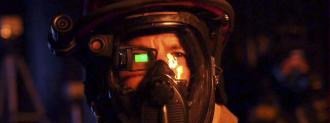Firefighters often go into burning buildings literally not knowing what’s ahead of them — the heavy smoke from a fire can make it impossible to see more than a few inches in front of their facemasks.
To combat the issue, they can crawl along the ground where the smoke isn’t as thick or use their hands to feel their way along walls, but that can slow their ability to put out a fire or rescue victims.
Thermal imaging cameras are a better solution as they can give a firefighter an idea of what’s around them. However, most of those devices are handheld, which means firefighters using them don’t have both hands available to actually fight the fire.
There’s also going to be smoke between the firefighter’s eyes and the screen, which could make it hard to see, and because they’re looking down, the firefighter’s reactions could be delayed.
Now, there’s another option: a heads up display that projects data from a thermal imaging camera right in front of a firefighter’s face.
C-THRU Heads Up Display
While exploring some active volcanic craters (as one does), entrepreneur Sam Cossman found himself essentially hiking blind through the smoke and steam. He wondered if there was some kind of device that would make it possible to see through haze.
Soon, the C-THRU Visual Communication platform was born.
The heads up display consists of a transparent piece of glass that sits inside a firefighter’s mask, right in front of one eye.
Outside the mask is a thermal camera that delivers a live feed to an AI — the device’s “brain.” The algorithm detects the edges of shapes in the camera’s view and outlines them in neon green.
Those outlines are then fed to the in-mask display, letting the firefighter see the ghostly green silhouettes of the objects in front of them — even in areas with heavy smoke.
The information from the system also feeds into a tablet-based application, which a commander outside of the burning area could use to coordinate the response for an entire crew of firefighters.
Augmented Reality for Firefighters
Qwake has already worked with several fire departments to see how its heads up display would perform in real-world scenarios, and the response has been incredibly positive.
“C-THRU is one of the first technologies I’ve seen that I think could literally change the game for us,” Marty McCormack, chief of the Boston Fire Department, told Forbes.
“The trial was a success as our guys immediately saw the value in being able to navigate, communicate, and coordinate visually,” he added.
In June, the U.S. Department of Homeland Security awarded Qwake a $1.4 million contract to work toward commercializing C-THRU.
The company has yet to announce a release date for the augmented reality device, but it is accepting reservations for it on its website alongside a note that more details can be expected in “early 2021.”
As for the price, that, too, is unknown, but in 2018, Cossman told CBS he expected the heads up display to cost less than the two-way radios firefighters currently use, and those run between $4,000 and $6,000.
We’d love to hear from you! If you have a comment about this article or if you have a tip for a future Freethink story, please email us at [email protected].






